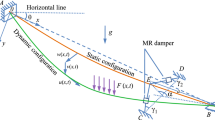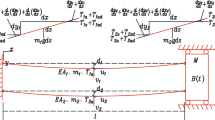Abstract
This paper minutely studies the effects of the damper on nonlinear behaviors of a cable–damper system. By modeling the damper as a combination of a viscous damper and a linear spring, the primary resonance and subharmonic resonance (1/2 order and 1/3 order) of the cable are explored. The equation of motion of the cable is treated by using Galerkin’s method, and the ordinary differential equation (ODE) is obtained subsequently. To solve the ODE, the method of multiple timescales is applied, and the modulation equations corresponding to different types of resonance are derived. Then, the frequency–/force–response curves are acquired by utilizing Newton–Raphson method and pseudo-arclength algorithm, so as to explore the vibration suppression effect from a nonlinear point of view. Meanwhile, the time histories, phase portraits and Poincaré sections are also provided to discuss the influences of the damping and spring stiffness on the nonlinear characteristics of the cable. The results show that the damper has a significant effect on nonlinear resonances of the cable, and the increase in damping (spring stiffness) makes the dual characteristic gradually convert to the softening (hardening) characteristic.




















Similar content being viewed by others
References
Cong, Y.Y., Kang, H.J., Yan, G.R., Guo, T.D.: Modeling, dynamics, and parametric studies of a multi-cable-stayed beam model. Acta Mech. 231(4), 1–24 (2020)
Xu, L., Hui, Y., Yang, Q.S., Chen, Z.Q., Law, S.S.: Modeling and modal analysis of suspension bridge based on continual formula method. Mech. Syst. Sig. Process. 162, 107855 (2022)
Wang, Z.Q., Kang, H.J., Sun, C.S., Zhao, Y.B., Yi, Z.P.: Modeling and parameter analysis of in-plane dynamics of a suspension bridge with transfer matrix method. Acta Mech. 225(12), 3423–3435 (2014)
Su, X.Y., Kang, H.J., Chen, J.F., Guo, T.D., Sun, C.S., Zhao, Y.Y.: Experimental study on in-plane nonlinear vibrations of the cable-stayed bridge. Nonlinear Dyn. 98(2), 1247–1266 (2019)
Irvine, H.M., Caughey, T.K.: The linear theory of free vibrations of a suspended cable. Proc. R. Soc. London. A. 341(1626), 299–315 (1974)
Rega, G., Luongo, A.: Natural vibrations of suspended cables with flexible supports. Comput. Struct. 12(1), 65–75 (1980)
Luongo, A., Zulli, D.: Dynamic instability of inclined cables under combined wind flow and support motion. Nonlinear Dyn. 67(1), 71–87 (2012)
Benedettini, F., Rega, G.: Planar non-linear oscillations of elastic cables under superharmonic resonance conditions. J. Sound Vib. 132(3), 353–366 (1989)
Zhao, Y.Y., Wang, L.H.: On the symmetric modal interaction of the suspended cable: three-to-one internal resonance. J. Sound Vib. 294(4–5), 1073–1093 (2006)
Rega, G.: Nonlinear vibrations of suspended cables–part I: modeling and analysis. Appl. Mech. Rev. 57(6), 443–478 (2004)
Krenk, S.: Vibrations of a taut cable with an external damper. J. Appl. Mech. 67(4), 772–776 (2000)
Tabatabai, H., Mehrabi, A.B.: Design of mechanical viscous dampers for stay cables. J. Bridge Eng. 5(2), 114–123 (2000)
Main, J.A., Jones, N.P.: Evaluation of viscous dampers for stay-cable vibration mitigation. J. Bridge Eng. 6(6), 385–397 (2001)
Main, J.A., Jones, N.P.: Free vibrations of taut cable with attached damper. I: linear viscous damper. J. Eng. Mech. 128(10), 1062–1071 (2002)
Main, J.A., Jones, N.P.: Free vibrations of taut cable with attached damper. II: nonlinear damper. J. Eng. Mech. 128(10), 1072–1081 (2002)
Krenk, S., Nielsen, S.R.K.: Vibrations of a shallow cable with a viscous damper. Proc. R. Soc. Lond. A. 458(2018), 339–357 (2002)
Caracoglia, L., Jones, N.P.: Damping of taut-cable systems: two dampers on a single stay. J. Eng. Mech. 133(10), 1050–1060 (2007)
Chen, L., Sun, L.M., Nagarajaiah, S.: Cable vibration control with both lateral and rotational dampers attached at an intermediate location. J. Sound Vib. 377(1), 38–57 (2016)
Zhou, H.J., Sun, L.M., Xing, F.: Free vibration of taut cable with a damper and a spring. Struct. Control Health Monit. 21(6), 996–1014 (2014)
Huang, Z., Jones, N.P.: Damping of taut-cable systems: effects of linear elastic spring support. J. Eng. Mech. 137(7), 512–518 (2011)
Li, H., Liu, M., Ou, J.P.: Negative stiffness characteristics of active and semi-active control systems for stay cables. Struct. Control Health Monit. 15(2), 120–142 (2008)
Shi, X., Zhu, S.Y., Nagarajaiah, S.: Performance comparison between passive negative-stiffness dampers and active control in cable vibration mitigation. J. Bridge Eng. 22(9), 04017054 (2017)
Johnson, E.A., Baker, G.A., Spencer, B.F., Fujino, Y.: Semiactive damping of stay cables. J. Eng. Mech. 133(1), 1–11 (2007)
Boston, C., Weber, F., Guzzella, L.: Optimal semi-active damping of cables with bending stiffness. Smart Mater. Struct. 20(5), 055005 (2011)
Chen, L., Sun, L.M.: Calibration of nonlinear damper for shallow cable based on forced vibration analysis. In: East Asia-Pacific conference on structural engineering & construction. pp. 1852–1859 (2017)
Yu, Z., Xu, Y.L.: Non-linear vibration of cable–damper systems. Part I: formulation. J. Sound Vib. 225(3), 447–463 (1999)
Xu, Y.L., Yu, Z.: Non-linear vibration of cable–damper systems. Part II: application and verification. J. Sound Vib. 225(3), 465–481 (1999)
Casciati, F., Ubertini, F.: Nonlinear vibration of shallow cables with semiactive tuned mass damper. Nonlinear Dyn. 53(1–2), 89–106 (2007)
Rega, G., Benedettini, F.: Planar non-linear oscillations of elastic cables under subharmonic resonance conditions. J. Sound Vib. 132(3), 367–381 (1989)
Gattulli, V., Morandini, M., Paolone, A.: A parametric analytical model for non-linear dynamics in cable-stayed beam. Earthq. Eng. Struct. Dyn. 31(6), 1281–1300 (2002)
Wang, Z.H., Gao, H., Fan, B.Q., Chen, Z.Q.: Inertial mass damper for vibration control of cable with sag. J. Low Freq. Noise Vib. Active Control 39(3), 749–760 (2020)
Pacheco, B.M., Fujino, Y., Sulekh, A.: Estimation curve for modal damping in stay cables with viscous damper. J. Struct. Eng. 119(6), 1961–1979 (1993)
Zhou, P., Li, H.: Modeling and control performance of a negative stiffness damper for suppressing stay cable vibrations. Struct. Control Health Monit. 23(4), 764–782 (2016)
Liu, T.T., Huang, H.W., Sun, L.M.: Optimal control of cable vibration using MR damper based on nonlinear modeling. In: The 2015 world congress on advance in civil, environmental, and materials research, Incheon (2015)
Lacarbonara, W., Rega, G., Nayfeh, A.H.: Resonant non-linear normal modes. Part I: analytical treatment for structural one-dimensional systems. Int. J. Nonlinear Mech. 38(6), 851–872 (2003)
Seydel, R.: Practical bifurcation and stability analysis. Springer, New York (2009)
Nayfeh, A.H., Balachandran, B.: Applied nonlinear dynamics. Wiley, New York (1995)
Luongo, A., Paolone, A.: On the reconstitution problem in the multiple time scale method. Nonlinear Dyn. 19(2), 133–156 (1999)
Zhao, Y.B., Lin, H.H., Chen, L.C., Wang, C.F.: Simultaneous resonances of suspended cables subjected to primary and super-harmonic excitations in thermal environments. Int. J. Struct. Stab. Dyn. 19(12), 1950155 (2019)
Zulli, D., Luongo, A.: Nonlinear energy sink to control vibrations of an internally nonresonant elastic string. Meccanica 50(3), 781–794 (2015)
Luongo, A., Zulli, D.: Nonlinear energy sink to control elastic strings: the internal resonance case. Nonlinear Dyn. 81(1), 425–435 (2015)
Su, X.Y., Kang, H.J., Guo, T.D.: Modelling and energy transfer in the coupled nonlinear response of a 1: 1 internally resonant cable system with a tuned mass damper. Mech. Syst. Sig. Process. 162, 108058 (2022)
Benedettini, F., Rega, G.: Non-linear dynamics of an elastic cable under planar excitation. Int. J. Nonlinear Mech. 22(6), 497–509 (1987)
Zhao, Y.B., Guo, Z.X., Huang, C.H., Chen, L.C., Li, S.C.: Analytical solutions for planar simultaneous resonances of suspended cables involving two external periodic excitations. Acta Mech. 229(11), 4393–4411 (2018)
Acknowledgements
The authors wish to acknowledge the support of the National Natural Science Foundation of China (11972151 and 11872176).
Author information
Authors and Affiliations
Corresponding author
Additional information
Publisher's Note
Springer Nature remains neutral with regard to jurisdictional claims in published maps and institutional affiliations.
Appendices
Appendix A
The expressions of the Galerkin integral coefficients in Eq. (10) are given as follows:
\(b_{11} = \omega_{c}^{2} = \frac{1}{{\int_{0}^{1} {\phi_{c}^{2} (x)} {\text{d}}x}}\left[K_{d} \phi_{c}^{2} (l_{1} ) - \frac{{\lambda_{c} \int_{0}^{1} {y^{\prime}_{c} (x)\phi^{\prime}_{c} (x)dx} \int_{0}^{1} {y^{\prime\prime}_{c} (x)\phi_{c} (x)dx} }}{{\beta_{c}^{2} }} - \int_{0}^{1} {\frac{{\phi_{c} (x)\phi^{\prime\prime}_{c} (x)}}{{\beta_{c}^{2} }}} {\text{d}}x\right]\);
\(b_{12} = \frac{1}{{\int_{0}^{1} {\phi_{c}^{2} (x)} {\text{d}}x}}\left[\mu_{c} \int_{0}^{1} {\phi_{c}^{2} (x)} {\text{d}}x + C_{d} \phi_{c}^{2} (l_{1} )\right]\);
\(b_{13} = \frac{1}{{\int_{0}^{1} {\phi_{c}^{2} (x)} {\text{d}}x}}\left[ - \frac{{\lambda_{c} \int_{0}^{1} {\phi^{\prime}_{c} (x)\phi^{\prime}_{c} (x){\text{d}}x} \int_{0}^{1} {y^{\prime\prime}_{c} (x)\phi_{c} (x){\text{d}}x} }}{{2\beta_{c}^{2} }} - \frac{{\lambda_{c} \int_{0}^{1} {y^{\prime}_{c} (x)\phi^{\prime}_{c} (x){\text{d}}x} \int_{0}^{1} {\phi^{\prime\prime}_{c} (x)\phi_{c} (x){\text{d}}x} }}{{\beta_{c}^{2} }}\right]\);
\(b_{14} = - \frac{1}{{\int_{0}^{1} {\phi_{c}^{2} (x)} {\text{d}}x}}\frac{{\lambda_{c} \int_{0}^{1} {\phi^{\prime}_{c} (x)\phi^{\prime}_{c} (x){\text{d}}x} \int_{0}^{1} {\phi^{\prime\prime}_{c} (x)\phi_{c} (x){\text{d}}x} }}{{2\beta_{c}^{2} }}\); \(F = \frac{{\int_{0}^{1} {F_{1} (x)\phi_{c} (x){\text{d}}x} }}{{\int_{0}^{1} {\phi_{c} (x){\text{d}}x} }}\); \(b_{15} = \frac{{F\int_{0}^{1} {\phi_{c} (x){\text{d}}x} }}{{\int_{0}^{1} {\phi_{c}^{2} (x)} {\text{d}}x}}\).
Appendix B
The expressions of the coefficients in Eqs. (22), (25), (42), (54), and (55) are given as follows:
\(\Gamma_{11} = \left( - 3b_{14} + \frac{{10b_{13}^{2} }}{{3\omega_{c}^{2} }}\right)\); \(\Gamma_{12} = \left(b_{14} + \frac{{2b_{13}^{2} }}{{3\omega_{c}^{2} }}\right)\); \(\overline{\Gamma }_{11} = \frac{{b_{12} b_{15} }}{{8\omega_{c} }}\); \(\overline{\Gamma }_{12} = - \frac{{b_{15} \sigma }}{{4\omega_{c} }}\); \(\overline{\Gamma }_{13} = - \frac{{5b_{13}^{2} b_{15} }}{{12\omega_{c}^{4} }} + \frac{{3b_{14} b_{15} }}{{8\omega_{c}^{2} }}\); \(\overline{\Gamma }_{14} = \frac{{7b_{13}^{2} b_{15} }}{{18\omega_{c}^{4} }} - \frac{{3b_{14} b_{15} }}{{4\omega_{c}^{2} }}\); \(\overline{\Gamma }_{15} = - \frac{{11b_{12} b_{13}^{2} }}{{9\omega_{c}^{3} }} + \frac{{3b_{12} b_{14} }}{{2\omega_{c} }}\); \(\overline{\Gamma }_{16} = \frac{{485b_{13}^{4} }}{{54\omega_{c}^{6} }} - \frac{{173b_{13}^{2} b_{14} }}{{6\omega_{c}^{4} }} + \frac{{15b_{14}^{2} }}{{8\omega_{c}^{2} }}\);
\(\Gamma_{21} = \frac{{b_{12}^{2} }}{4} - 6b_{14} \Lambda^{2} + \frac{{3b_{13}^{2} \Lambda^{2} }}{{\omega_{c}^{2} }} - \frac{{4b_{13}^{2} \Lambda^{2} }}{{\Omega (\Omega + 2\omega_{c} )}}\); \(\Gamma_{22} = \frac{{b_{13} \Lambda \sigma }}{{\omega_{c} }}\); \(\Gamma_{23} = - \frac{{2b_{12} b_{13} \Lambda \Omega }}{{\Omega^{2} - \omega_{c}^{2} }}\); \(\Gamma_{24} = - 3b_{14} + \frac{{10b_{13}^{2} }}{{3\omega_{c}^{2} }}\).
\(\Gamma_{31} = - 3b_{14} \Lambda - \frac{{4b_{13}^{2} \Lambda }}{{\Omega (\Omega - 2\omega_{c} )}} - \frac{{2b_{13}^{2} \Lambda }}{{3\omega_{c}^{2} }}\); \(\Gamma_{32} = - b_{12} \omega_{c}\); \(\Gamma_{33} = - 6b_{14} \Lambda^{2} - \frac{{4b_{13}^{2} \Lambda^{2} }}{{\Omega (\Omega - 2\omega_{c} )}} + \frac{{4b_{13}^{2} \Lambda^{2} }}{{\omega_{c}^{2} }} - \frac{{4b_{13}^{2} \Lambda^{2} }}{{\Omega (\Omega + 2\omega_{c} )}}\); \(\Gamma_{34} = - 3b_{14} + \frac{{10b_{13}^{2} }}{{3\omega_{c}^{2} }}\).
Appendix C
To seek a second-order approximation, the solution of qc is uniformly expanded in power series of ε, namely
Here, it should be noted that qc is found to be independent of T1 by eliminating the secular terms in the equation of order \(\varepsilon^{1}\). Therefore, T1 is dropped in Eq. (C.1). Following similar treatment to that of higher-order expansion, the following autonomous modulation equations can be derived:
Letting \(D_{2}^{1} a = D_{2}^{1} \alpha = 0\) and eliminating \(\alpha\), Eqs. (C.2) and (C.3) can be simplified as
The stable solutions of the system can be obtained according to Eq. (C.4).
Rights and permissions
About this article
Cite this article
Su, X., Kang, H., Guo, T. et al. Nonlinear planar vibrations of a cable with a linear damper. Acta Mech 233, 1393–1412 (2022). https://doi.org/10.1007/s00707-022-03171-0
Received:
Revised:
Accepted:
Published:
Issue Date:
DOI: https://doi.org/10.1007/s00707-022-03171-0




